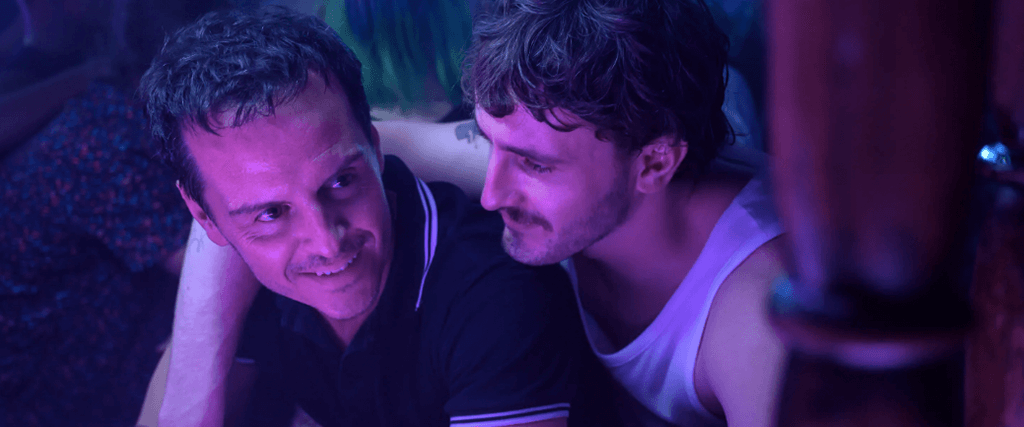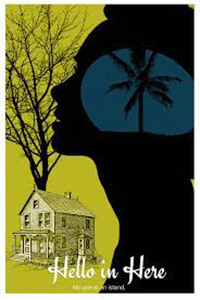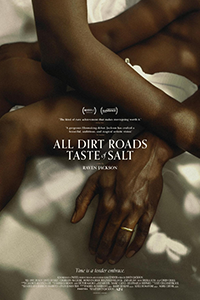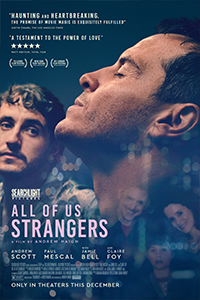
Twin Cities Film Fest 2023 – Dispatch 1
By Brian Eggert | October 23, 2023
The Twin Cities Film Fest (TCFF) runs in a hybrid format from October 19 to October 28. Order tickets or buy a streaming pass on the TCFF website, or check out the in-person screenings at the ShowPlace ICON Theatres at the West End in St. Louis Park, MN. Some of the short takes below will be expanded into full-length reviews to coincide with the film’s official release. In the meantime, here are my initial impressions.
 Hello in Here
Hello in Here
If the few movies about COVID-19 quarantines indicate anything, it’s that society doesn’t yet know how to adequately confront the psychological impact of what people experienced, and everyone’s experience was different. Personally, being a homebody and having social anxiety, I didn’t mind quarantines all that much. But then again, I also had my wife and dog to keep me company. Had I been alone all that time, perhaps I would have come out the other end a little squirrellier.
Writer-director Casey McAdams tells a story about solitude and quarantine madness in Hello in Here, a feature exploring the solitude and banal routines of COVID-19 lockdown. Most of the 90-minute feature takes place in a single location, following Kara, played in an admirable performance by Chynna Walker. Kara’s quarantine begins well enough, with her regime established in short bursts by the production’s uncredited editor. Mornings begin with the harsh sound of her coffee maker. She works from her home office at a nondescript corporate job, writing emails and attending virtual conference calls on Microsoft Teams. Every day looks the same. Yoga. Television. Language learning courses. Social media. Puzzles. Lots of wine.
Each of these experiences, repeated ad nauseam by design, occupies a few seconds of screentime. If not for the abrupt editing that makes Hello in Here feel like a feature-length montage at times, the film might be a pandemic answer to Chantal Akerman’s Jeanne Dielman, 23, quai du Commerce, 1080 Bruxelles (1975). Watching the film is about noting the gradual decline of Kara’s composure and noticing the breaks in her pattern, especially after she’s furloughed from her job and desperate loneliness and boredom take over.
But unlike Akerman’s subtle work of observation, McAdams also deploys alternately idyllic and terrifying dream sequences—a recurring one set on a beach, another in a creepy fairy tale nightmare. By the time Kara is brought to the brink of sanity, her frayed mind is reflected in the lightning-flash editing of random freaky imagery. Unfortunately, the script never quite gets into Kara’s head enough for these visuals to have a profound meaning for the character, beyond their surfaces.
Walker’s screen presence keeps the viewer invested through the monotony, but there’s not enough to sustain the viewer’s interest in Kara’s wearisome routines. It’s only when Kara’s composed facade begins to crack that Hello in Here becomes more than a series of familiar observations about quarantining, but even then, the cracks materialize in cliché ways (like when Kara cries while singing “Silent Night” to herself around Christmas). Maybe the subject matter is too soon or too familiar, or maybe McAdams’ perspective on lockdown doesn’t have anything new to say, but the film doesn’t have much of an impact or novelty. Regardless, it’s put together well by McAdams, and Walker’s performance signals a clear talent. 2/4 Stars.
 All Dirt Roads Taste of Salt
All Dirt Roads Taste of Salt
There’s a shot in writer-director Raven Jackson’s debut film, All Dirt Roads Taste of Salt, that pauses on a vase containing yellow roses. The vase is slightly to the right of center in the frame, situating the shadow, cast across the wall by the low evening sun, in the center of the shot. From this pointed moment, it could be argued that much of Jackson’s film is interested not in the subject of what occurs in her film but in its impressions—the feelings and residues of life that emerge after time has passed. With this conceptual thesis guiding Jackson, her film is a beautifully made work of visual poetry that eschews a conventional narrative structure to dwell instead on textures, sounds, and sensory details, creating a wealth of sensations in the viewer.
Shooting on 35mm, Jackson and cinematographer Jomo Fray keep the camera just off to the side of where traditional filmmakers might point it. Much of the film lingers on hands and what they touch, producing imagined tingles on our fingertips—the characters’ sense memories of a time and place. Set in rural Mississippi, the film is a series of recollections that unfold in nonlinear order from the mind of Mack (Charleen McClure). The first scenes show her father, Isaiah (Chris Chalk), teaching the preadolescent Mack (Kaylee Nicole Johnson) how to fish. She touches the scales of a sunfish and pets the slimy black skin of a catfish. Later, her mother (Sheila Atim), teaches Mack and her sister Josie (Jayah Henry) how to clean and prepare the day’s catch at the kitchen table. She also maintains a tenuous, years-long relationship with a boy, Wood (Reginald Helms Jr.).
Later, the film catches up with Mack in her twenties, and again at older times in her life, alternating between events in a free association. Although what happens in the film could be summed up in a few short sentences—a first kiss, a parent’s funeral, a childbirth, a marriage—there’s a lifetime of evocative imagery that establishes pathways to other memories. Editor Lee Chatametikool creates a mosaic of timelines with an impressionistic structure that has been compared to Terrence Malick’s cinema, but Jackson is doing something far more experimental and elusive than even Malick’s most ephemeral output. Meanwhile, there may be walkouts or patrons falling asleep, because the film doesn’t spoon-feed itself to viewers who just want to be entertained.
Even within this evocatory agenda, some of Jackson’s themes become overemphasized within the minimal dialogue. For instance, the film’s visual and aural concentration on water is unmistakable. Rainfall, cleansing baths, and hands exploring the feeling of mud under the shallows underscore the notion that time and generations flow into one another—from Mack’s mother to her daughter. One particularly memorable shot observes the way underwater mud and sediment resemble clouds, moving in billowing formations beneath the surface as the distant sound of thunder echoes the connection. But Jackson unnecessarily underlines the point when, later on, Mack explains to her daughter that water never disappears; it merely changes form—a notion that most people watching an arthouse film like this would surely interpret without punctuating it with dialogue.
Nevertheless, All Roads Taste of Salt takes its time to cast its spell, to welcome you into its rhythms, and shake off any notion of adhering to standard narrative formats. But once it does, the delicacy and refinement of the imagery and immersive sound design reveal boundless feelings. Despite its narrative minimalism, it’s stunning how Jackson conjures an understanding of her characters, and not even on intellectual terms, but on terms that can only be felt and expressed through sound and vision. 3.5/4 Stars.
 All of Us Strangers
All of Us Strangers
Andrew Scott and Paul Mescal give raw, sublimely devastating performances of quiet intensity in Andrew Haigh’s All of Us Strangers, an aching exploration of solitude, artistic creation, memory, and the ghosts of long-gone family members. The writer-director of Weekend (2011) and 45 Years (2015) adapts Taichi Yamada’s 1987 novel Strangers, applying his queer experience to a story about a screenwriter who ruminates on the loss of his parents for his latest project. Rooted in tender emotions and situations that might register as cliché in another filmmaker’s hands, Haigh’s greatest achievement here might be the casting, giving the stars of TV’s Fleabag and last year’s Aftersun, respectively, another showcase for their incredible talent.
Scott plays the contemplative Adam, who lives in a London high-rise, one of the only tenants in a newly constructed building. Laboring over his latest screenplay that explores his childhood in 1987, the year his parents died in a car accident, Adam rummages through the artifacts of his past, such as reruns of Top of the Pops and a bin of old belongings. He takes day trips by train to his childhood home in rural England, visiting his old playground and a field. While there, his father (Jamie Bell) spies him and gestures for him to follow. At first, it’s not entirely clear that Adam’s parents have died, or whether what we’re seeing is real. But Adam visits his childhood home, having been absent for many years now, and finds his mother (Claire Foy) overjoyed to see him in disorienting yet curiously cozy scenes.
At the same time, Adam meets Harry (Mescal), who drunkenly knocks on Adam’s apartment door after they spy each other through the window. Although Adam initially turns down Harry’s forward advance, they share a solitude that soon prompts Adam to start a romance with his neighbor from a few stories down. What initially begins with an erotic exchange of pot and sexual openness evolves into the two men bonding over their pain, from discussing their experiences growing up gay, to their preferences between the labels “queer” or “gay,” to their relationships with their parents. As a writer, Adam confronts his parents’ deaths in ways he seemingly never has before, while Harry’s pain is less specific and contained inside. Harry attempts to disguise his damaged persona, covering up his isolation and ache with substances and his immersion in their new relationship. But with Harry’s utterance of lines like “I know how easy it can be to stop caring about yourself,” the character’s pain becomes palpable in Mescal’s terrific embodiment.
Even though it’s an open-wound-of-a-film, Haigh lends a dreamlike, at times even Lynchian quality to All of Us Strangers. Adam’s trips home register as the mental work of a writer exploring his past, suggesting that perhaps those train rides to his childhood home occur in his head. “Memory train?” I scribbled in my notes. When Adam is drawn further into Harry’s orbit, their romance grows. They visit a club and lose themselves in ketamine—a mind-splitting experience for Adam, recalling scenes of fractured transition in Lost Highway (1997). Along with his interest in Adam’s unambiguous queer identity, and how such an identity has changed between 1987 and 2023, Haigh embraces the protagonist’s subconscious ambiguity, submerging Adam and the viewer into ethereal but emotionally concentrated scenes of long-overdue reconciliation. But when Adam attempts to bring Harry into the experience, Haigh challenges our understanding of what is real and what is imagined.
How much of All of Us Strangers takes place in Adam’s head? That answer is open to a rewarding debate. Haigh seems to indicate what we perceive becomes our reality, even if our perceptions are rooted in memories and ghosts, or projections of ghosts. However, when we spend too much time inside a phantasmagoric headspace of the past, those memories can destabilize our present and future. Haigh never resorts to nostalgia or cheap tricks to explore these ideas. Every moment, no matter how small, feels intimate, personal, and specific—and always with an astral, otherworldly quality to cinematographer Jamie D. Ramsay’s lensing. The final moments may seem almost sentimental, with their starry deployment of Frankie Goes to Hollywood’s “The Power of Love”—bound to be a divisive moment for many—but there’s an overwhelming personal quality to every choice in All of Us Strangers that registers as genuine and feeling, even during its more abstract moments. 4/4 Stars.
Thank You for Supporting Independent Film Criticism
Thank you for visiting Deep Focus Review. If the work on DFR has added something meaningful to your movie watching—whether it’s context, insight, or an introduction to a new movie—please consider supporting it. Your contribution helps keep this site running independently.
There are many ways to help: a one-time donation, joining DFR’s Patreon for access to exclusive writing, or showing your support in other ways. However you choose to support the site, please know that it’s appreciated.
Thank you for reading, and for making this work possible.
Brian Eggert | Critic, Founder
Deep Focus Review




